[Fix] ‘Microsoft Game Input’ Causing Blue Screen of Death on Windows 11
Some Windows 11 are reporting that they are now dealing with frequent BSOD (blue screen of death) critical errors and all of them seem to be related to a process called ‘Microsoft Game Input‘. Most affected users have discovered that this process is responsible for this error by running the Reliability Monitor to locate the timing of the app reconfiguration when experiencing the error. This particular problem seems to be much more frequent on Windows 11.
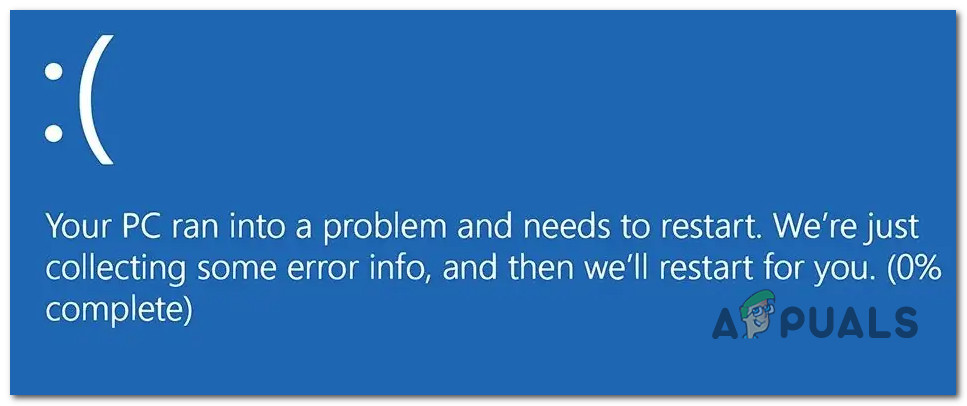
After we’ve investigated this issue thoroughly, we realized that there are actually several different underlying causes that might ultimately cause this BSOD pointing towards the Microsoft Game Input process.
Here’s a short list of scenarios that might be ultimately causing this critical error on Windows 11:
- Missing Windows infrastructure update – As it turns out, one quite frequent scenario that might indirectly cause this ‘Microsoft Game Input’ BSOD is when your Windows 11 computer is missing a key feature update of the Microsoft Store component. The get this issue resolved, simply access the Windows Update component and install the pending update.
- Failing RAM – Under certain circumstances, you can also expect to deal with this issue when your RAM component is beginning o fail. To verify this theory, you should stress test your RAM sticks and see if any of them need to be replaced.
- Outdated or incompatible chipset drivers – If you’re coming over to Windows 11 from an older Windows version as a result of an upgrade, one of the first things you should do is make sure that your chipset drivers are updated for Windows 11.
- Outdated BIOS or UEFI version – An outdated BIOS or UEFI interface might also indirectly cause this type of BSOD in scenarios where your BIOS version is dated before the official launch of Windows 11 so there’s no official support for this OS at a Kernel level. To resolve this issue, you’ll need to update your BIOS or UEFI version to the latest version available.
- 3rd party interference – If you’re only experiencing this type of issue during specific intervals, there’s a chance you’re dealing with this type of BSOD due to some kind of 3rd party interference. Since there’s impossible to create a definitive list of every possible culprit, the best thing you can do is perform a clean boot and then systematically re-enable every service, startup item, or process until you discover the culprit.
- System file corruption – System file corruption can also be an underlying cause why you might experience this type of problem on Windows 11. If the critical crashes occur due to a corrupted system file, try running SFC and DISM scans in quick succession. If this fails, use System Restore to return your PC back to a healthy state or consider going for a clean install or repair install if the issue persists.
- Failing disk sectors – As it turns out, this particular problem can also originate from a series of storage sectors that are beginning to fail. In this case, the only thing you should do (besides changing the drive) is to deploy a CHKDSK scan in an attempt to replace the corrupted items with unused equivalents.
- Corrupted Windows account – According to several affected users, this particular issue can also occur due to some kind of corruption affecting your currently signed-in Windows account. Several affected users dealing with the same kind of problem have confirmed that they managed to get the issue fixed by creating a new account or by transitioning to a local account.
Now that we went over every potential cause that might ultimately trigger this error on Windows 11, let’s go over a series of fixes that other affected users have successfully used to prevent the BSOD from ever occurring again (or at least lessen its frequency).
1. Install every pending Windows update
As it turns out, if your Windows 11 PC is missing a crucial feature update for the Microsoft Store component, this “Microsoft Game Input” BSOD may occur inadvertently. Simply access the Windows Update component and install the pending update to cure this problem.
The simplest approach to install it is to enter the Windows Update component and set it to automatically install all pending updates since Microsoft has already produced an update designed to address this problem and it is now available through all channels.
Several people who are also experiencing the hotspot issue that we are have reported that the problem resolved itself once they made sure that Windows 11 was updated to the most recent version.
How to do it is as follows:
- The Run dialog box will appear when you press the Windows key + R.
- The Settings program’s Windows Update tab will then show up once you type “ms-settings:windowsupdate” and press Enter.
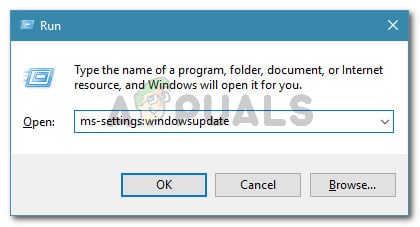
Access the Windows Update component - In the right-hand pane, after choosing the Windows Update tab, click Check for updates. Wait for the initial scan to complete before continuing.

Checking for updates - Once the scan is complete, begin installing any recommended updates. Follow the on-screen directions to install them one at a time.
Note: If you haven’t had a chance to install all of the pending updates, restart your computer when prompted to do so. But keep in mind to return to the same window at the subsequent startup to complete each update installation and bring your Windows to build up to date. - After each update has been installed, restart your computer, and then verify that the problem has been resolved when the system starts up again.
Continue to the next technique below if you’re still seeing the same BSOD (pointing at the Game Input process).
2. Test your RAM
You might also anticipate experiencing this problem if a component of your RAM starts to malfunction. You should stress test your RAM sticks to check if any of them need to be changed in order to confirm this notion.
The Microsoft Game Input BSOD error is frequently linked to a memory problem. You should also take the time to test your RAM stick(s) to check if there’s a problem with them that could cause your OS to default to a critical crash whenever it has no other choice if the aforementioned procedure has brought you near to probable offenders.
If you have dual-channel RAM installed, you can start troubleshooting by removing just one stick to check if the error persists.
Additionally, you ought to check the integrity of your RAM stick(s) using a program like Memtest.

Important: If your RAM is already overclocked, we advise reversing any voltage overclocked frequency and using a program like HWMonitor to monitor your temps while performing a stress test.
You are essentially left with no choice but to hunt for a replacement if performing a Memtest program on your RAM has identified a memory problem.
You should move on to the next potential solution below if this method didn’t help you identify a fundamental RAM problem.
3. Reinstall Chipset drivers
Make sure your chipset drivers are up to date for Windows 11 if you’ve upgraded from an earlier version of Windows to Windows 11. This is one of the first things you should do.
It turns out that this specific problem frequently arises when you’re utilizing a motherboard that is intended to function with an Intel chipset driver. The necessary chipset drivers should be installed by your operating system automatically if you’re using Windows 11.
But if you want to stop the BSOD crashes from happening, you probably need to do so manually on older versions of Windows (or if your copy of Windows is not active).
Here is a simple tutorial for using the Intel Driver & Support Assistant (Intel DSA) to automatically install the necessary Intel Chipset drivers:
- To get the Inter Driver Support assistance, visit the home page and click on the Download Now button.
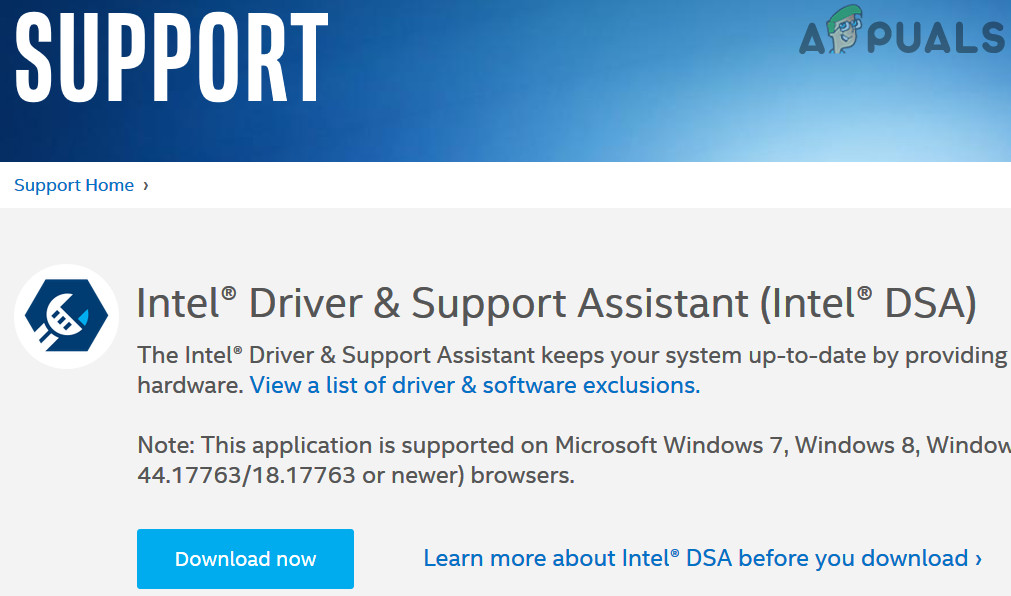
Access the Intel Support Assistant - After the installation application has finished downloading, double-click it and follow the on-screen instructions to set up the Intel Support Assistant on your computer.
Note: The ‘I agree to the licensing terms and conditions‘ box must first be checked before clicking Install and selecting Yes from the UAC prompt.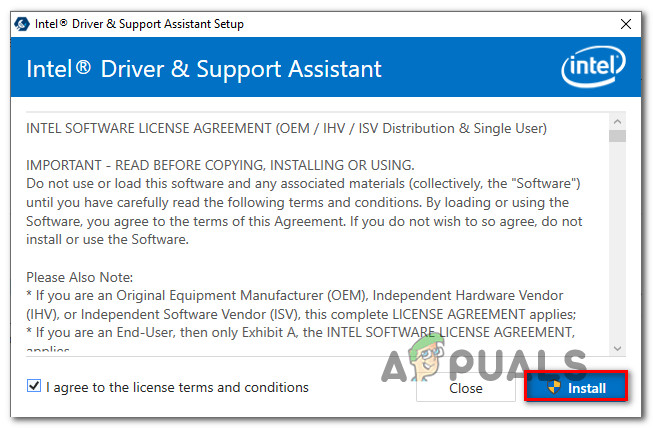
Installing the Intel support utility - After the installation is finished, use the Intel Support Assistant and adhere to the on-screen instructions to install all outstanding Intel Drivers including the chipset drivers.
- After installing all pending drivers, shut off the utility and restart your computer. See if the problem has been fixed when the computer starts up again.
Continue to the next method below if you’re still experiencing BSOD crashes linked to the “Microsoft Game Input” process even after you’ve used the Intel Support Assistant to update the chipset drivers.
4. Update BIOS or UEFI Drivers
If your BIOS version dates from before Windows 11’s official debut, there is no official support for this OS at the kernel level, and this could indirectly be caused by an obsolete BIOS or UEFI interface. You must update your BIOS or UEFI to the most recent version available in order to fix this problem.
In certain circumstances, an outdated BIOS version that wasn’t fully compliant with Windows 11’s new security protocols was the main culprit behind this kind of issue. To make sure that this isn’t the cause of the issue, you should be able to fix it by flashing your BIOS with the most recent version available.
You could look into your BIOS as well because it’s another possible offender. Several impacted consumers assert that the problem was fully resolved after updating their BIOS firmware to the most recent version. With ASUS PCs, this technique has mainly been demonstrated to be effective.
It’s uncommon for an outdated BIOS version to cause system instability, especially on older motherboards.
The big motherboard manufacturers now all offer flashing software that enables you to do so without needing to be extremely tech-savvy, so changing your motherboard’s BIOS isn’t as difficult as it once was.
The best step to take is to go to the website of the manufacturer of your motherboard and search the Drivers Download section for a BIOS updating tool. E-Z Flash by ASUS, MFlash by MSI, @BIOS Live Update by Gigabyte, and so forth.
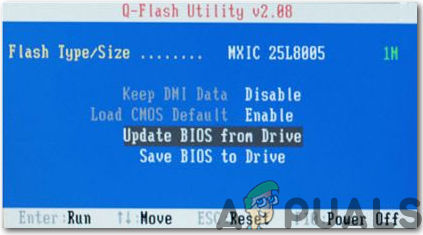
Note: Before beginning the upgrade procedure, read the official documentation in its entirety, regardless of who made your BIOS. A knowledgeable professional should be consulted if you want to avoid bricking the hardware by doing this method wrong.
Follow the on-screen instructions to update your BIOS, then after restarting your computer, check to see whether you can boot with the secure boot feature activated.
If you already have the most recent BIOS for your motherboard or if updating didn’t work for you, try the next method below.
5. Perform a clean boot
There’s a potential you’re dealing with this form of BSOD because of interference from a third party if you’re only encountering this problem at certain times.
The best thing you can do is conduct a clean boot and then gradually re-enable each service, starting item, or process until you identify the culprit because it’s impossible to make a complete list of every potential culprit. In this situation, you should be able to resolve the problem by starting in clean boot mode and following a set of procedures to look for a software conflict and pinpoint the problematic service or process.
Your machine will boot without any third-party services, processes, or startup items in order to establish a clean boot state, which may prevent the appearance of this issue.
The detailed procedures for achieving this clean boot condition are provided below:
- To enter the Run dialog box, first, click Windows key + R. The System Configuration window will then appear once you enter “msconfig” into the text box.
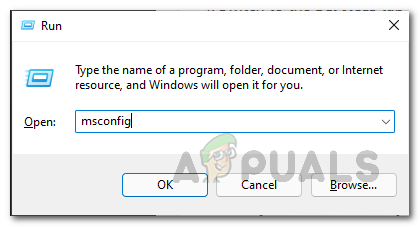
Access the msconfig Note: If the User Account Control (UAC) popup asks you to provide admin access, click Yes.
- Select the Services tab from the ribbon bar at the top of the System Configuration menu, then check the box next to Hide all Microsoft services.
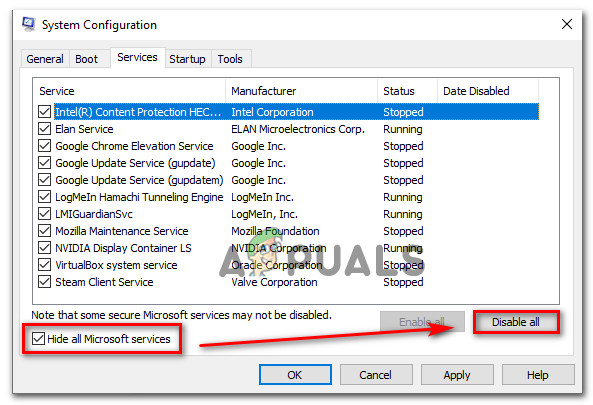
Accessing the Startup Services screen Note: A Microsoft service that is crucial to your OS will not be disabled as a result of this action.
- After removing every necessary service from the list, click the Disable all button to ensure that no third-party services are launched when your system restarts.
- After selecting the Startup tab, select Open Task Manager from the drop-down box.
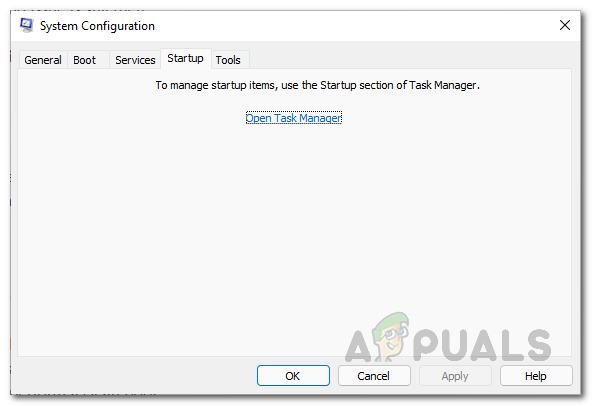
Open Task Manager - The preceding operation will immediately take you to Task Manager’s Startup tab. Once inside, go through each third-party startup service one by one and click the Disable button at the bottom of the screen to prevent them from starting the next time the system boots.
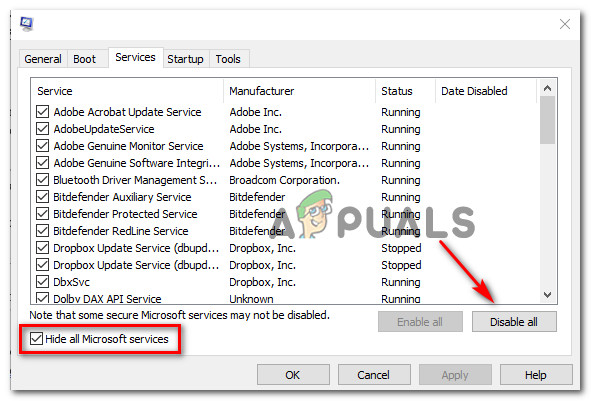
Disabling 3rd party services Note: Keep doing this until there isn’t any startup service left that can be started at the next boot.
- If you have made it this far, you are prepared to carry out a clean boot. Restarting your computer is all that’s left to do to see if the screen flickering problem has been resolved.
- Your computer will only boot with the fundamental services needed by your operating system the next time it is powered on. Use your computer normally when the procedure is finished to check if the screen flickering has returned.
- Restart all previously deactivated processes and start items one at a time until the problem reappears. This makes it simple to identify the offender who is to blame for the screen flickering.
- Reverse engineer the preceding instructions to make sure that your next computer setup is normal and that 3rd party services, processes, and startup items are allowed to operate, regardless of the results.
If you were unable to resolve the problem using this approach, proceed to the probable solution below.
6. Deploy SFC & DISM scans
If the clean boot procedure above didn’t allow you to fix the ‘Microsoft Game Input’ error, the next thing you should do is troubleshoot against potential system corruption issues.
The vast majority of probable problems that could be causing this error code can be fixed by quickly executing SFC (System File Checker) and DISM (Deployment Image Servicing and Management) scans.
The two built-in programs are somewhat similar, but to improve your chances of fixing the problem without needing to perform a clean install or repair install, we advise performing both types of scans quickly after one another.
An SFC scan should be your first step. NO Internet connection is needed because this scan will use a local archive to replace damaged Windows files with healthy ones.
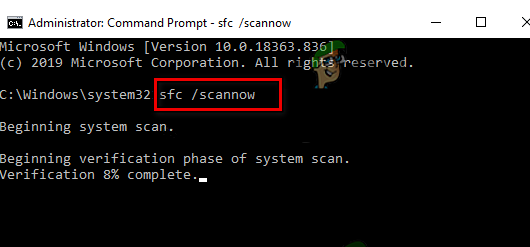
Avoid restarting or shutting down your computer or closing the elevated CMD window after commencing this process.
By doing this, you run the chance of additional local problems harming your HDD or SSD on your PC.
Restart your computer after the SFC scan is finished, then start a DISM scan when it starts back up.

Note: Unlike an SFC scan, DISM needs a steady Internet connection in order to swap out faulty files for their healthy counterparts. This is required because DISM downloads fresh copies that are untouched by corruption utilizing a component of Windows Update rather than a local file archive like SFC.
Restart your computer one last time when the DISM scan is finished, then check to see if the issue has been resolved.
Continue to the next possible solution below if the issue is still present.
7. Deploy a CHKDSK scan
It turns out that this specific issue could potentially result from a number of failing storage sectors. The only thing you should do in this situation (apart from upgrading the drive) is to run a CHKDSK scan in an effort to replace the corrupted items with their unused counterparts.
If you ever find yourself in this situation, run a CHKDSK (Check Disk Scan) to make sure that no logical sectors are to blame for your strange behavior. If this is what caused the critical crash, CHKDSK will swap out the damaged logical sectors for their healthy, unused counterparts.
Note: Every current Windows version, including Windows 7 and Windows 8.1, comes with CHKDSK pre-installed.
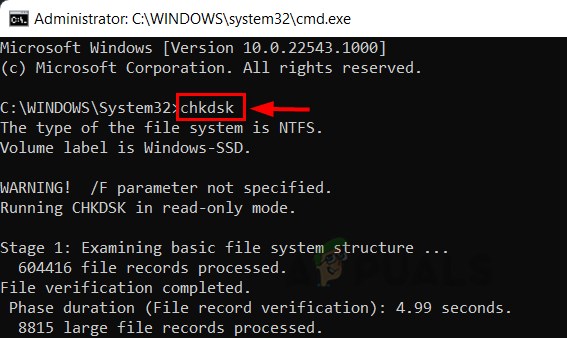
Important: If the tool finds some unrepairable corrupted sectors, you can infer that the drive is failing and you should start looking for a replacement right once.
If you’ve already run a CHKDSK scan and the problem is still there, continue to the next possible solution below.
8. Create a new Windows account
Many people who have experienced this problem claim that it might also happen because your currently logged-in Windows account is corrupt, according to multiple afflicted users. Several concerned individuals who were experiencing the same type of issue have indicated that they were able to resolve it by either creating a new account or switching to a local account.
To be sure your current account is not the issue, create a new Windows account (it can be local) and restart the remote desktop service.
It’s vital to understand that by doing this operation, all damaged dependencies linked to your current user profile will be removed.
You can avoid the ‘Microsoft Game Input’ BSOD error entirely by using the following procedure to create a new user account:
- Press the Windows key + R to open the Run dialog box.
- To open the Family & Other People tab in the Settings app, next type “ms-settings:otherusers” in the text field and press Enter.
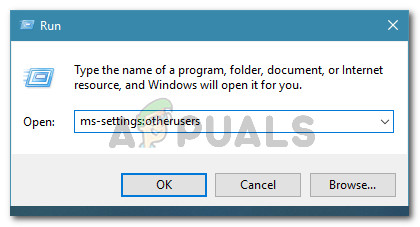
Access the other users menu - On the Other Users screen, select Add someone else to this PC from the Family & other users menu.
- Completing the remaining procedures to establish a new Windows account, restarting your computer, and logging in with the new account will allow you to check whether the remote service can be started normally.
Continue to the next method below if the same “Microsoft Game Input” BSOD problem persists.
9. Use System Restore
If all else fails, you can attempt to resolve the “Microsoft Game Input BSOD” by reverting your PC to an earlier system restore point when this pesky critical crash was not occurring.
This has helped several users find a solution to the problem. You can restore your computer to a previous state using Windows’ System Restore feature.
To get your computer back in working order, follow these steps:
- To launch the Run command, press the Windows key + R.
- To launch the System Restore wizard, type “rstrui” in the Run box and press Enter.
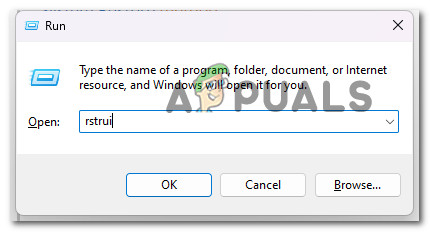
Deploy the rstrui menu - Choose a different restoration point on the following screen, then click the Next button.
Note: Be sure to choose a restore point that was created before you discovered this mistake, then click Next once more.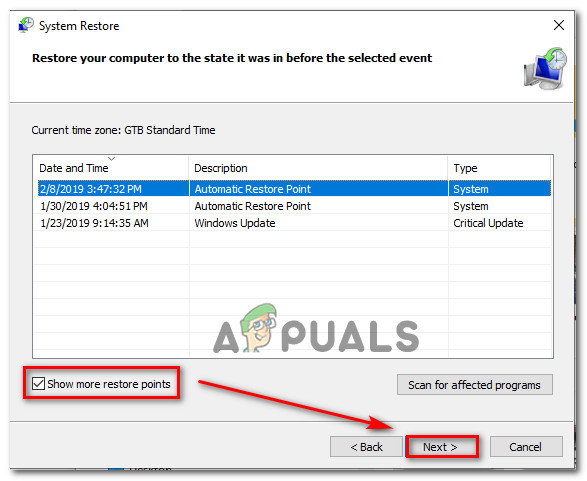
Restore to a previous point in time using RSTRUI - After the restoration process has begun, click Finish and watch as your computer restarts.
- Restart your Windows computer to check whether the issue has been rectified and to see if the error’s symptoms have disappeared.
Continue to the final method below in the event that the issue is still not resolved.
10. Perform a clean install or repair install
If you’ve tried every solution given in this article so far and are still getting the BSOD warning “Microsoft Game Input,” you most definitely have a serious corruption problem.
To ensure that every instance of faulty system files is eliminated in this situation, you must restart every component of Windows.
A clean install, which accomplishes the work while also wiping all personal data, including programs, games, media, and documents, is the option most users choose.
Selecting a repair install will allow you to upgrade your Windows components in a less extreme manner without risking any damage to your personal property (games, apps, images, papers, etc.). You can preserve all of your personal info using this way.





